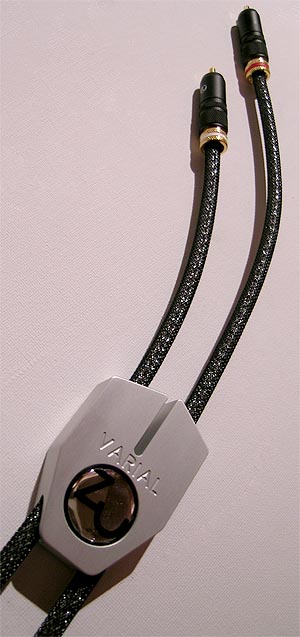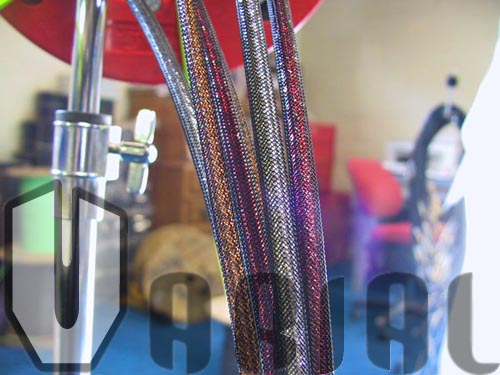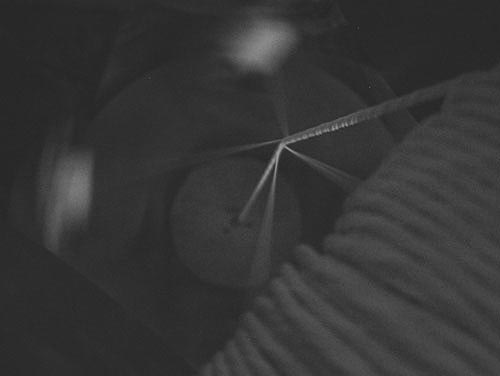|
This review page is supported in part by the sponsor whose ad is displayed above
|
|||||||||||
 |
|||||||||||
| Zu Cable Varial Based on my very positive encounters with this company's loudspeakers, I already knew that Zu designers Sean Casey and Adam Decaria do things differently. However, there's nothing frivolous or amateurish about this difference but solid engineering reasons and audibly satisfactory results. Seeing that Sean had worked for Ray Kimber to help spearhead his Kimber Select line before going solo, I had reason to believe that Sean's own cables would be more than smoke and mirrors just like the speakers. At $495/1m/pr, the Zu Cable Varial is the most affordable entry of today's three contenders. All the same, it's the most expensive single-ended interconnect Zu Cable makes. Let that sink in for a moment. Any BS-savvy marketing whiz would surely not price his flagship product this low. Nor would he allow the associated propaganda to be as minimal and only reluctantly expounded upon as is the case at Zu. Still, there is a story. What follows is as much as Zu was willing to divulge. (Its principals were vacillating between sending me the graphic representation of B3's electromagnetic model or not. They eventually decided to wait about another year.) |
|||||||||||
| You see, Zu cables are based on what's claimed to be a "fundamentally new cable design model based on correlative electrodynamic relationships". According to Sean, all audio cables on the market today are variations on twisted pairs, braids or coaxials which, themselves, trace back to Edison and Tesla (i.e. old stuff). B3 revolves around the specific relationships of electrical and magnetic fields, boundary effects and how those relate to virtual ground planes. This model/geometry is not specific to materials, chemistry, treatment processes or "HiFi mumbo-jumbo marketing". More specifically, "B3 is not a straight or twisted pair, star-quad, Gore®-quad, braid, interleave, full or sectional coax, ribbon, sectional ribbon, radial, concentric or any other known cable format. Nor has it anything to do with conductor shape or groupings such as elliptical, rectangular, Litz, tubular, concentric, ropes, variable stranded and so on." B3 affords "increased immunity from both electric and magnetic interferences and lower reactance (both XI and Xc) compared to known cable designs of similar conductance and inherent EMI resistance. B3 also dramatically reduces the dielectric space penetrated by the electrical and magnetic fields. Properly implemented, B3 further increases bandwidth, lowers group delay, reduces phase shifts, eliminates standing waves within the cable and provides a proportional and linear relationship between capacitive (Cp) and inductive (Ls) potential differentials. Relative to the desired characteristics and actual electrical measures, B3 reduces cable diameter. The geometry also proves easily scalable and is readily maximized for a specific application. This does not affect propagation velocity. B3 can be established in both single-ended or balanced transmissions, including balanced differential, two-channel balanced, single-ended, two-channel single-ended and for poly-phase/poly-signal distribution in shared space". |
|||||||||||
 |
|||||||||||
| The fabrication of B3 cables required that special machines be engineered and built. These hand-operated machines and the B3 model are proprietary to Zu. Manufacture of these cables (not merely off-the-spool termination) occurs in Ogden/Utah at Zu. About the Varial, Sean offered the following: "Admittedly, our B3 overview is a bit dry unless you are an E&M or Tesla freak. The | |||||||||||
| Varial is Zu's top-of-the-line interconnect. It fully expresses our B3 cable geometry and all constituents of the cable serve the geometry. Many cable companies focus on metallurgy in their marketing propaganda to justify costs. With ultra-refined nine 9s copper, silver, gold, Palladium or other materials, customers feel better to part with their money. It's the glitter mentality. However, nothing trumps cable geometry where seniority of importance is concerned. The primary characteristics of any electrical cable (resistance/R, capacitance/C and inductance/L plus the losses and operative bandwidth fixed by the connector) are determined by the magnetic and electrical relations and current capacity. Everything else is much farther down the totem pole." |
|||||||||||
"The use of copper, silver or gold influences these measures very little if at all. That's not to say the use of specific materials does not influence the sound. But those are secondary and tertiary phenomena well past the electrodynamic design. The Varial does use silver and copper in its metallurgy and due to the nature of modern smelting, refining and processing, the material is intrinsically pure, single-crystal stuff. On a side note, the highly refined processes involved to extract gold, neodymium, molybdenum and other precious metals from raw copper is a profit center for mining companies. It's curious how audiophiles believe that they benefit from some kind of exclusive smelting/refining process." |
|||||||||||
 |
|||||||||||
| "To obtain low-grade copper really requires you go looking for it. The term silver alloy for the Varial is technically incorrect. We take advantage of specific boundary advantages that are formed between a copper core and its silver deposit. This technology derives from military/aerospace research like most breakthroughs that trickle down into audio cables. Zu, like all performance-driven audio cable companies, looks as closely as credentials permit to the military for their material sciences. But again, these are secondary to and only serve the prime influencing factor, the cable's dynamic electro-magnetic behavior, i.e. cable geometry. Beyond B3, we spent a lot of time on the secondary aspects of the | |||||||||||
 |
|||||||||||
|
Early prototype color choices
|
|||||||||||
| Varial which became a complex and longwinded process due to the sheer number of variables involved. The dielectric in the Varial is tetra-fluorinate, a Teflon-type material doped with titanium dioxide. There's secondary screening to shunt RF to ground via an aluminum alloy. Termination is completely solderless since we don't believe that the introduction of contact resistance is a good thing. We cold-forge the conductor with a high-pressure crimp to the pin and plug tulip. This connection is then hermetically sealed with a special putting compound. The outer jacket is black polyester for appearance and the machined billet-aluminum V-block keeps pairs matched and indicates directionality, with the point of the V aimed at the load. As far as electrical parameters go, here they are: Varial 1.0m (3.3') terminated with phono (RCA-type) connectors - DCr (center pin) 0.013 Ohms; DCr (pin's mate) 0.013 Ohms; Cp (pin / ground) = 286 pF (open); Ls (center pin) 1.2 uH (open); Ls (pin's mate) 1.2 uH (open); DCr (shield) shunted to earth at load only; R/T -t (1kHz - 100 MHz) +/- 2 nsec (min delay 2 nsec, maximum delay 6 nsec); bandwidth +/- 1.dB > DC - 100MHz; linear phase." |
|||||||||||
| "What else would people find interesting, maybe more on the human side of things? My partner Adam Decaria and I have been doing audio since we were kids and more or less grew up in loudspeaker design and playback. We both studied applied physics at WSU and are continually studying, researching and investigating the world around us. I was drawn to high-efficiency transducers very early and knew that science and music excited me (as did dirt bikes, motocross and well, I also had some interest in playing doctor with the neighbor's girls but that was when I was really young and still destroying my toys to get whatever motors and magnets I could from them). Adam who really rather not talk about his early days has a deep-seated | |||||||||||
 |
|||||||||||
|
Early 2001 cable manufacturing machine detail
|
|||||||||||
| passion for applied physics and a true passion for exploration and innovation in all aspects of life. Just as we don't believe that revelation from God is dead (yes, we're Mormons) we also believe that every man and woman has access to inspiration and is capable of great things. We do not compare ourselves to the greats like Tesla and Einstein but how exciting would it be to model original ideas completely in your head, refine them until you get them so precise that translation into the material domain works right off the bat? Well, we have to work pretty hard for our insights and realizations. We're certainly a passionate bunch here at Zu and very happy and grateful to be making products that are appreciated by peers and fellow music lovers." From Cerious to Zu, from a focus on new materials to a focus on electromagnetic behavior as determined by geometry. Our third entry has already been extensively reviewed in these pages, hence I shall merely touch on the key features of the Stealth Audio Indra. It's based on a military or aerospace origin amorphous alloy conductor of extreme thinness. Amorphous alloys are first molten, then centrifugally spun, then cooled so rapidly as to prevent the formation of regular crystalline molecular structures. The end result is a glass-like zero-crystal frozen-liquid state in which a metal no longer exhibits its conventional crystalline lattice makeup. Manufacture of such glass metals is essentially cost-prohibitive for most consumer audio cable manufacturers and to my knowledge, only Van denHul at present makes its own amorphous conductors. Intense research into amorphous materials occurs in the hi-tech sector since such material variants possess unusual electrical, magnetic and other characteristics. Stealth proprietor Serguei Timachev obtained a limited amount of raw amorphous conductor from Russia and applied all of his prior cable design expertise to turn it into a limited edition flagship interconnect. Amorphous metals can't be soldered, hence termination requires a crimp connection. But why stop there? Serguei decided that even the best low-mass WBT NextGen and Eichmann silver bullet plugs weren't good enough. So he designed his own RCAs, using a hollow silver pin with Teflon center to cold-weld the connector to. The outer barrel is a Teflon-reinforced Carbon fiber hull, the return contacts are three low-mass narrow silver slivers embedded in the RCA barrel according to the Eichmann principle. The Indra is also cryogenically treated. |
|||||||||||
 |
|||||||||||
Serguei believes that low-level signal cables work best with minimum gauge conductors - the thinner the better, with the only practical limitation reliability to fashion a cable that won't break. Timachev also builds Carbon fiber cables (as does Van den Hul). For more information on the Stealth Indra, revisit its reviews: 1, 2 and 3. The Indra is frightfully expensive but -- based on personal comparisons as well as those of fellow reviewers here and elsewhere -- one of the best analog interconnects presently made (and some believe the best, period). As a known quantity, the Indra in this 3-piece review will serve as a proven example for what's possible at the cutting edge of cable design when money, time and handcrafting nightmares are no consideration. |
|||||||||||
 |
|||||||||||
 |
|||||||||||
 |
|||||||||||